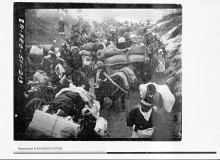January 24, 2014
At a public lecture on Friday, January 24, 2014, organized by the Centre for the Study of Korea, Professor Janice Kim (York University) examined the largest evacuation movement of the Korean War, the January 4th Retreat of 1951. The contents of this lecture were largely drawn from the fifth chapter of her forthcoming book, based on a wide variety of historical sources such as the official accounts of the South Korean Ministries of Social Affairs and Defense, the UN Civil Assistance Command in Korea, the US State Department, the CIA, and newspaper sources, as well as interviews and memoirs in Korean.
The January 4th retreat on the Korean peninsula, which saw evacuations from both sides of the 38th parallel, included three different groups of people for relief: refugees from the north, the internally displaced from the south, and war sufferers. Professor Kim highlighted some of the remarkable aspects of the January 4th retreat, such as relief activities, assistance across the provinces, as well as continued hostilities on both sides of the border. Professor Kim’s lecture was accompanied by over a dozen black-and-white photographs of migration around the retreat period, such as the refugees on the road and the living conditions on ships.
By the fall of 1950, retreat efforts were already beginning to surface. Most people were fleeing as families and expected to return at some point. December 1950 marked another turning point in the war. After less than two months of occupation, the UN allied forces withdrew from Pyongyang. The UN troops took all North Korean records but left the civilians behind. The evacuation of Heungnam, known as the most successful evacuation campaign, saw over 300,000 people who tried to get on to ships and about 90,000 were transported in the ten days from December 14 to Christmas Eve in 1950. The gathering and movement of refugees generally caused great disturbances in the cities and the ships were often extremely crammed, where people could not eat or drink for nearly a week. Many of the refugee camps had hygiene issues and illnesses spread quickly under the crowded living arrangements.
Over the course of the January 4th retreat, close to 80–90% of Seoul’s 1.2 million residents evacuated. The Han River remained frozen during the retreat period but it was nevertheless a very difficult process as many of the evacuees carried heavy loads with them. Unfortunately, the UN Convention on the Status of Refugees was largely focused on Europe in the 1950s and the Koreans were left out of the UN refugee definition. Between January and June, the figures for refugees fluctuated greatly, and by the summer of 1951, estimates ranged anywhere from 5 to 8 million people. A general refugee registration system enacted in April 1952 saw over 10 million people who identified themselves as refugees.
Q&A Highlights:
How does your current focus on refugees compare to your previous focus on comfort women?
Janice Kim (JK): In fact, my current project has distinctly Torontonian origins. I was asked for comment on a TVO documentary on the Korean War in 2003 and saw how the local population was treated as a massive flock of people in white clothes. The scholarship on refugees during the Korean War is extremely limited, which prompted me to examine the subject at a deeper level. More personally, my extended great-aunt died of pneumonia shortly after the January 4th retreat. Because of the stigma involved in discussing such a dark period of history and the difficulty in engaging people about some very personal – and often tragic – history, not much work has been done on the subject in a systematic manner. So, I would say this project has been inspired by a number of forces in my life.
During your talk, you asserted that “wartime was when Koreans were confronted with modernity.” Can you elaborate on this statement?
JK: We have over-emphasized modernity during the Japanese era. Newspapers and periodicals published in Seoul or Pusan show that neither was a terribly modernized place, especially in terms of its ability to hold people. Pusan had a population of 200,000 before the Japanese era. When you count those who returned from Osaka, population increased to more than 400,000. Infrastructure for water was bad to begin with (not enough water) but you had another 400,000 without infrastructure. Everything was made more difficult by the geography. By the January 4th retreat, 1.3 million people were in Pusan and there was not enough water for drinking and washing. In the frigid winter climate, the camp followers had to wash off blood with frozen water. You could say that the Koreans were confronted by modernity or the limits of modernity featured under the colonial period.
What was the situation like in Seoul around this evacuation period?
JK: Seoul’s population was about 1.3 million and it did not re-populate itself until 1953. This brings us back to the concept of refugees. The UNHCR had established itself by this point but the Koreans were not included until 1967. There were separate projects like the Palestinian issue which occupied the UNHCR. Korea was number two but until 1967, the UN dealt with refugee issues largely on an ad-hoc basis. Korea was unlike any other refugee situations in that there were only temporary camps. The logic was based on the fluid lines. Most likely, these people would not be able to go back to their place of origin.
Read the event description including speaker bio and abstract here.
Interviewed by Tina J. Park, a Ph.D. candidate in the Department of History, specializing in Canadian-Korean relations in the 20th century. She is a Junior Fellow at Massey College.
